How to avoid having your photos stolen
If you share or publish your photos online, it is very likely that at some point they'll be used by someone else without your permission, and without crediting you as the photographer.
You can never really prevent people from stealing your work (unless you never display it on the web or anywhere else). But there are a number of things you can do to to discourage potential image thieves.
Use a small size
If you only ever upload small sizes of your photos to the internet, this limits the potential usage of the image to thieves somewhat. A small photo will be no use for people to steal and give away as a free desktop background, and it won't be suitable for people wanting to use it for print work.
However, small size images will still be good enough for use on websites, so you aren't making the image unusable to thieves. You also need to consider the effect on viewers of your images. Larger images generally look better and have a greater impact, so you are giving this up if you only share small images.
Use a watermark
A watermark is a logo or piece of text (usually semi-transparent) that is placed over part of the image. This makes the image less attractive to potential image thieves as the watermark makes it obvious where the photo comes from or who it was taken by.
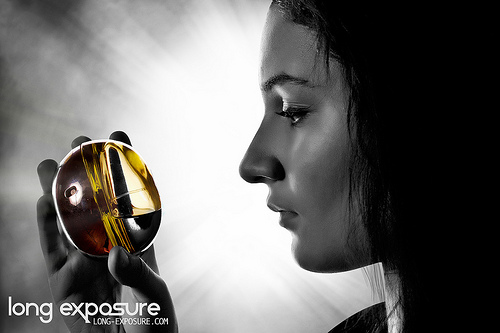
_MG_2495_ by TriggerHappyDave on flickr (licensed CC-BY)
Even if a watermarked photo is used without your permission, at least the watermark gives you some form of credit as the photographer.
Normally watermarks are placed in one of the corners of the image, to keep out of the way and avoid detracting attention from the subject of the photo. However, this does mean that some people may clone away the watermark, or crop the image to remove it, before using your photo illegally.
To prevent this, you can use a large watermark that goes across the image. You may find that this detracts from the image too much though.
If you decide to take someone to court for copyright infringement, then having used a watermark on your image can make it easier to prove that the infringement was willful.
Adding a watermark to your photo is quite simple, here is a video that shows one way of doing it using Photoshop Elements:
Embed copyright info
You can use EXIF / IPTC metadata to embed your copyright information in the image. Most image organization software allows you to add this information.
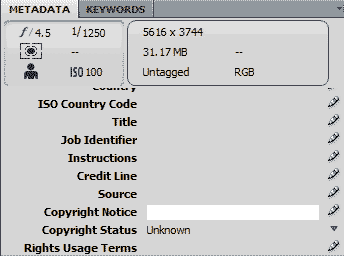
Adding copyright information using the metadata panel in Adobe Bridge
This is not very strong protection against theft, as anyone can easily change this information, or remove it completely.
Digital Watermark
Some software (e.g. the full version of Photoshop) allows you to add a digital watermark to your photos. This is an invisible watermark that can only be detected by special software. Even if someone alters your image, the digital watermark should remain.
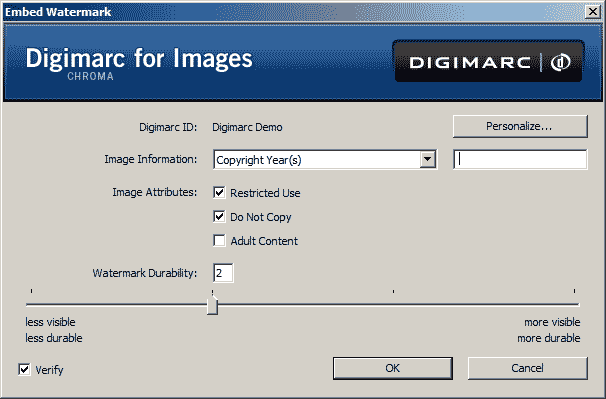
The Digimarc dialog used for adding digital watermarks to images in Adobe Photoshop
A digital watermark is similar to embedding your copyright data in the EXIF, but is much harder to remove. This can be used to prove that a copied image is yours.
Use a copyright notice
Writing in plain text next to your image that the image is copyrighted and not to be used without permission might deter some people from using your images. It won't deter everyone, but many people might not realize it is illegal to use photos without the copyright holder's permission. Including this message make it clear.
If you take someone to court for copyright infringement, it makes it easier to prove that the infringement was willful as well.
An example for copyright text would be:
© 2012 Your Name All Rights Reserved. No unauthorized use allowed.
Register your copyright
In most countries copyright is automatic. You have the copyright to the photo as soon as you take it. But in some countries (e.g. the U.S.) you need to register your copyright if you want to be able to claim damages and legal fees for unauthorized use.
Although it's not on the topic of images, this article gives a good overview of the benefits of registering your copyright: 6 Reasons to Register Your Site with the U.S. Copyright Office.
Give your images away
If you don't mind people using your images, but would at least like to get some credit as the photographer, you can use a license to let people do this. Creative Commons is probably the most popular license that allows people to use images for free. It comes in various flavors, so you can choose whether people are allowed to use the image for commercial use, or whether they are allowed to modify the image.
As part of the license conditions, it specifies that the licensee (the person using your photo) must give credit to the author (you) and preferably a link back to your website / the original image page.
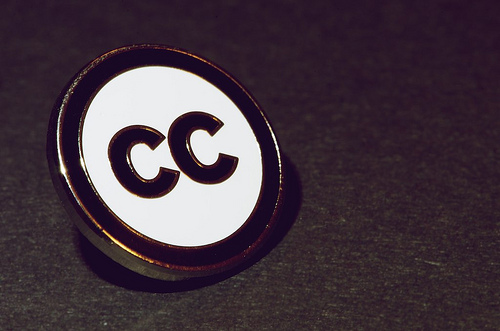
Creative Commons by Kalexanderson on flickr (licensed CC-BY-SA)
By providing a way for people to use your images legally, they are more likely to follow the licensing instructions and give you credit and a link back than they are if they want to use an image where no free license is available. That is, in theory at least. I have not seen any evidence either way to indicate if this is true.
The benefit of being credited for your work is that you will become more well known, and more people will appreciate your photography. Having a link back to the original photo or your website also means that people might click through from where the image was used. And having more links back to your images or website also improves your rankings in the search engines like Google.
If you don't want other people to use your images without your explicit permission, make sure you don't upload them to websites like Flickr with a creative commons license. If you want people to request permission before using the image, your image should have an all rights reserved copyright status. Then in the description for the image you can write that a free license for using the image is available upon request.
Detecting infringements
To see where else an image has been used on the internet, you can use the website TinEye Reverse Image Search. This allows you to input the url of one of your photos or upload a photo. It can then show you where else on the web that image has been used.
Help, my photo has been stolen!
If you find a photo has been used without your permission, there are a couple of things you can do.
Contacting the infringer
The first thing you can do is to contact the person using your image without permission. If it is being used on a website and there is no contact information displayed anywhere on the website, you can do a whois search. Using a service like whois.net, just type in the domain name of the infringing website. This will then bring up a page with contact details for that domain.
Send them a polite but firm letter detailing the infringing image and the exact location of the image on their website. Ask that the image be removed immediately. You can also request fees for the unauthorized use of the image (this can work particularly well if you have registered the copyright for the image). Giving them a deadline to remove the image by should help spur them into action.
If you post the letter rather than sending an email, this seems more official and is less likely to be ignored.
Going to court
If the person ignores your letter, you could consider taking them to court. Sometimes just receiving the court summons will be enough to cause the infringer to remove the image and / or pay any licensing fees they should have paid for use of the image.
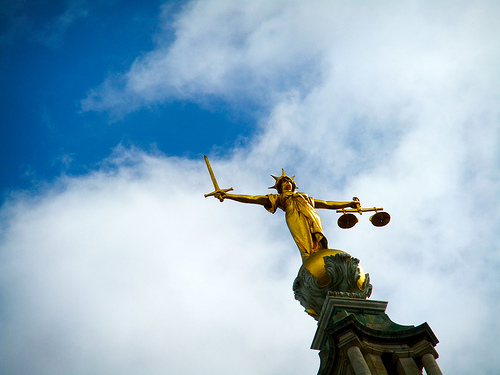
The scales of justice by James Cridland on flickr (licensed CC-BY)
If you do decide to take someone to court, remember that an individual may not be able to pay the damages and your legal fees. So even if you win, you could still end up out of pocket. If the infringement was not willful, suing the person does not put across a great image of yourself either.
Issuing a DMCA takedown notice
If the image is being used without permission on a website, then you can issue a DMCA takedown notice to the ISP that hosts the website. This requires the ISP to remove the image, and they may well shut down the infringer's website completely.
Rather than explain the procedure here, there is a very good article on it here: How to Send a DMCA Takedown Notice.
If you are concerned about your photos being used without permission, you can use a combination of the above techniques to help reduce copyright infringements.




